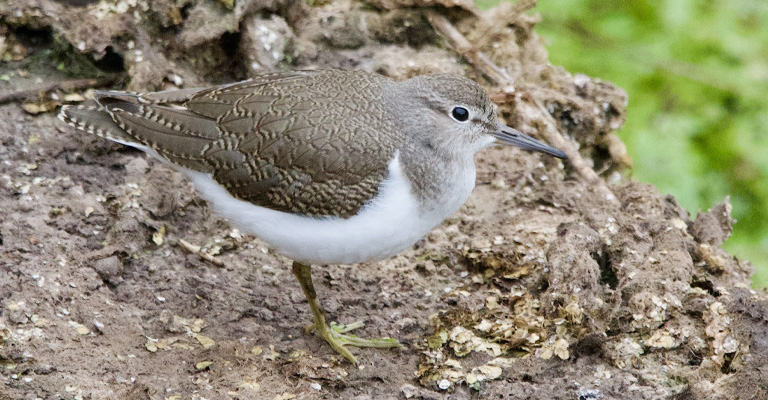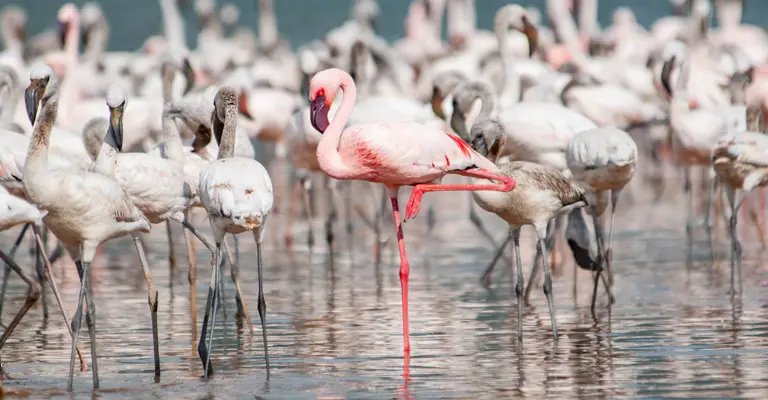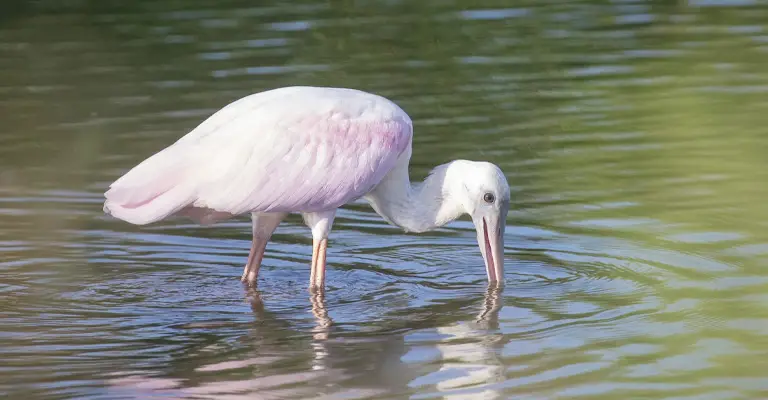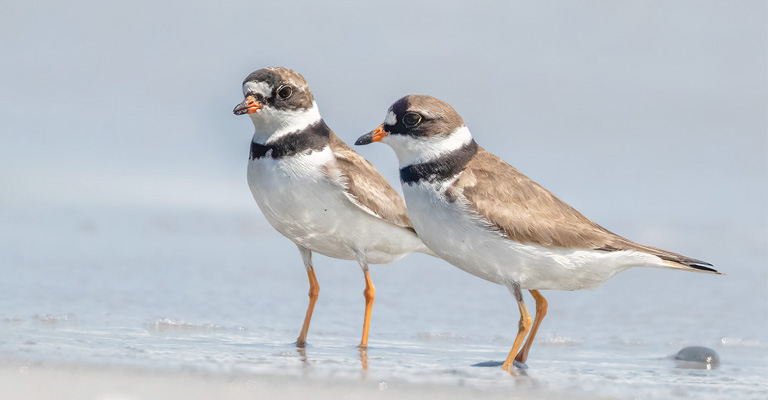The peculiar sight of sandpipers hopping on one leg has long piqued the curiosity of bird enthusiasts and naturalists alike.
These graceful shorebirds, found in various coastal and wetland habitats around the world, exhibit this behavior for a multitude of reasons, reflecting their remarkable adaptations to their environments.
While it might seem like a whimsical act, hopping on one leg serves several vital functions in a sandpiper’s daily life. From conserving energy during long migrations to regulating body temperature and enhancing their foraging efficiency, this behavior is a testament to the intricate ways in which birds adapt to their surroundings.
This intriguing phenomenon invites us to explore Why do Sandpipers sometimes hop on one leg and the intricate dance between nature and adaptation that unfolds along the shorelines and wetlands.

Why Do Sandpipers Sometimes Hop On One Leg?
Sandpipers, like many shorebirds, are known for their distinctive behavior of hopping on one leg. This peculiar action serves several crucial purposes in their daily lives, and here are some reasons behind this behavior:
Rest and Energy Conservation
Hopping on one leg allows sandpipers to rest one leg at a time, conserving energy during their long migratory flights and foraging activities. By periodically switching legs, they reduce muscle fatigue and optimize their overall energy expenditure.
Thermoregulation
Sandpipers often inhabit cold coastal environments. By lifting one leg, they minimize heat loss through the uncovered leg and reduce their exposure to frigid water or air, helping to maintain their body temperature in challenging conditions.
Predator Alertness
Hopping on one leg enables sandpipers to remain vigilant for potential predators. With one leg raised, they can swiftly react to threats or the approach of predators, giving them a better chance to escape danger.
Reduced Footwear Wear
Sandpipers have delicate feet adapted for walking on soft, muddy substrates. By periodically lifting a leg, they reduce wear and tear on their feet, preventing potential injury or damage from abrasive surfaces.
Enhanced Foraging
Sandpipers are skilled foragers that probe mud and sand for invertebrates. Hopping on one leg allows them to maintain balance while searching for food beneath the surface, helping them locate prey more effectively.
Communication
Sandpipers use a variety of visual signals to communicate with each other. Hopping on one leg can be a part of their communication repertoire, conveying information about their physical condition, readiness to mate, or territorial boundaries.
Species-specific Behavior
Some species of sandpipers have developed the habit of hopping on one leg as a distinctive feature. This behavior can help distinguish different sandpiper species, aiding in their identification by ornithologists and birdwatchers.
The habit of hopping on one leg among sandpipers is a multifaceted behavior with significant functional advantages, including energy conservation, thermoregulation, predator awareness, and foraging efficiency, among others.
This unique behavior showcases the remarkable adaptations these birds have developed to thrive in their coastal habitats.
What Other Birds Hop On One Leg?
Hopping on one leg is not a behavior limited to sandpipers alone. Several other bird species exhibit this fascinating trait for various reasons, often related to resting, thermoregulation, or balancing.
Here are some birds known for their one-legged hopping:
Flamingo (Phoenicopteridae)

Flamingos are iconic for their one-legged stance. They often stand on one leg to conserve heat, as their long, slender legs can lose heat rapidly in cold water.
This behavior also helps them reduce muscle fatigue and optimize energy use during long periods of standing in shallow water while foraging for food.
Stilt (Himantopus spp.)
Stilts are elegant wading birds known for their long, thin legs. Like flamingos, they often stand on one leg to regulate body temperature and reduce heat loss. This behavior is particularly useful in their wetland habitats.
Spoonbill (Platalea spp.)

Spoonbills, characterized by their distinctive spatula-shaped bills, also display one-legged resting behavior. They lift one leg while standing in shallow waters during feeding to stay alert and conserve energy.
Ibis (Threskiornithidae)
Many ibis species, such as the sacred ibis, exhibit the one-legged stance. This behavior helps them regulate body temperature, rest during long periods of foraging, and stay vigilant for predators.
Plovers (Charadriidae)

Some species of plovers, like the Killdeer, are known for their one-legged behavior. It serves as a way to conserve energy during rest breaks, and they also use it as part of their distraction display when nesting to divert predators away from their nest.
Herons (Ardeidae)
Several heron species, including the Great Blue Heron, adopt the one-legged posture when foraging or resting. This behavior aids in energy conservation and heat regulation, especially in cooler weather.
Crane (Gruidae)

Cranes, such as the Sandhill Crane, are large birds often seen standing on one leg. They employ this behavior to rest during long periods of foraging and to reduce heat loss through their legs, which are exposed in their wetland habitats.
In these bird species, the one-legged stance is a remarkable adaptation that helps them survive and thrive in their respective environments. It not only aids in energy conservation and thermoregulation but also plays a role in predator awareness and efficient foraging, making it a valuable aspect of their behavior.
What Are The Habits Of Sandpipers?
Sandpipers are a diverse group of shorebirds found worldwide, known for their distinctive habits that enable them to thrive in coastal and wetland habitats. Here are some key habits of sandpipers:
Foraging in Mud and Sand
Sandpipers are renowned for their exceptional feeding behavior. They use their long bills to probe mud and sand for aquatic invertebrates, such as worms, insects, and crustaceans.
Their specialized bills are adapted for extracting prey from the substrates of tidal flats and marshes.
Migration
Many sandpiper species undertake impressive long-distance migrations, covering thousands of miles between their breeding and wintering grounds. This migratory behavior is driven by seasonal changes and the need to find suitable breeding and feeding areas.
Group Foraging
Sandpipers often forage in large flocks, a behavior that offers several advantages. Group foraging increases the chances of locating food, provides safety from predators through collective vigilance, and allows individuals to share information about food availability.
Territorial Displays
During the breeding season, male sandpipers engage in elaborate territorial displays to attract females. These displays can involve aerial acrobatics, vocalizations, and ground-based dances, showcasing the males’ fitness and suitability as mates.
Nesting on Ground
Many sandpiper species build their nests on the ground, often in well-hidden locations among vegetation. Their nests are simple scrapes in the soil, and they lay speckled eggs that blend in with their surroundings to minimize the risk of predation.
Intraspecific Aggression
Sandpipers can be territorial and engage in aggressive interactions with other individuals, especially during the breeding season when resources are limited. These confrontations can include bill jabbing, wing flapping, and vocalizations.
Camouflage
Sandpipers often rely on camouflage as a defense mechanism. Their plumage blends in with their sandy or muddy habitats, making them less conspicuous to both predators and prey. Some species can even adjust the color of their plumage to match their surroundings.
These habits have evolved over time to help sandpipers effectively exploit their specific niches in coastal and wetland ecosystems.
From their unique foraging techniques to their remarkable migratory journeys, sandpipers are well-adapted to their dynamic and challenging habitats, playing important roles in these ecosystems’ food webs and nutrient cycles.
FAQs
Why do sandpipers hop on one leg?
Sandpipers exhibit the behavior of hopping on one leg primarily as a means of conserving energy. By resting one leg at a time, they reduce muscle fatigue, especially during long flights and foraging activities.
This adaptation allows them to optimize their energy expenditure, which is crucial for their survival in their challenging coastal habitats.
Is hopping on one leg a common behavior among sandpipers?
Yes, hopping on one leg is a common behavior observed in various sandpiper species. It’s prevalent across different habitats and serves as a universal strategy for energy conservation, allowing sandpipers to sustain their active lifestyles without overexerting their muscles.
Does hopping on one leg help sandpipers regulate body temperature?
Yes, hopping on one leg assists sandpipers in thermoregulation. By tucking one leg close to their bodies, they minimize heat loss, especially in cold water or air. This behavior enables them to maintain their body temperature, ensuring they remain active and alert in diverse weather conditions.
Do sandpipers hop on one leg during foraging activities?
Yes, sandpipers often hop on one leg while foraging. This behavior allows them to maintain balance while probing mud and sand for prey. By alternating legs, they effectively search for invertebrates beneath the surface, enhancing their foraging efficiency in their natural habitats.
Is hopping on one leg a defense mechanism for sandpipers?
While not primarily a defense mechanism, hopping on one leg does enhance sandpipers’ vigilance against predators. By keeping one leg raised, they can swiftly respond to threats, enabling quick take-offs if necessary.
This heightened awareness contributes to their overall safety in the wild, aiding their survival against potential predators.
Conclusion
In the world of birds, sandpipers’ one-legged hopping represents a fascinating convergence of form and function.
As we conclude our exploration of this behavior, it becomes evident that these birds have evolved a multifaceted adaptation strategy to thrive in their dynamic coastal and wetland habitats.
Their ability to conserve energy, regulate temperature, and stay vigilant against predators exemplifies the ingenuity of nature’s designs.
The hopping sandpipers serve as a reminder of the intricate relationship between birds and their environments, highlighting the importance of preserving these critical ecosystems.
By studying and appreciating these small but remarkable creatures, we gain a deeper understanding of the beauty and resilience of the natural world, encouraging us to protect and conserve these fragile habitats for generations to come.